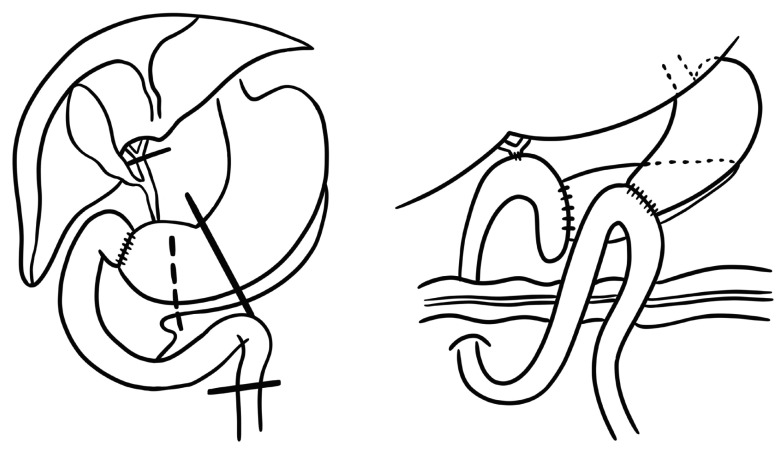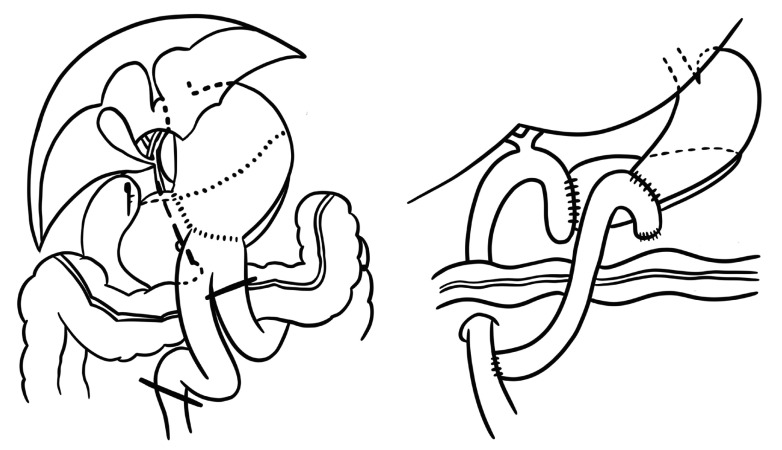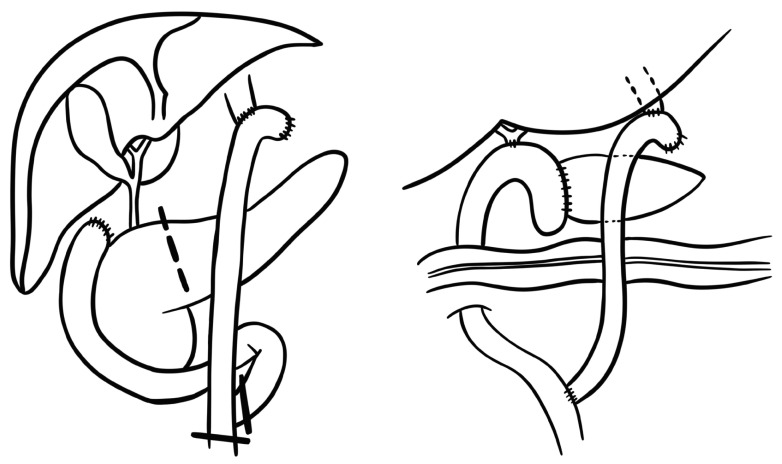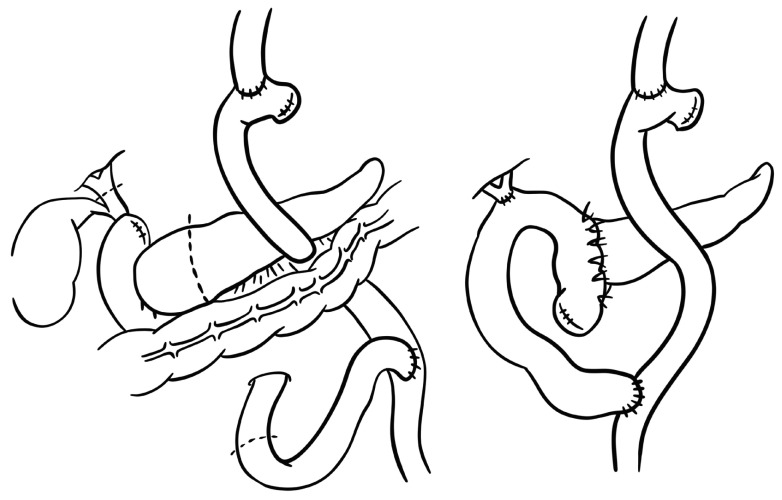Ann Surg Treat Res.
2022 Jun;102(6):323-327. 10.4174/astr.2022.102.6.323.
Various types of reconstruction after pancreaticoduodenectomy for the patients who underwent all types of gastrectomy: a single-center experience
- Affiliations
-
- 1Department of Surgery, Kyungpook National University Chilgok Hospital, Daegu, Korea
- KMID: 2530386
- DOI: http://doi.org/10.4174/astr.2022.102.6.323
Abstract
- Purpose
The incidence of patients requiring pancreaticoduodenectomy (PD) following any type of gastrectomy is increasing as the population of elderly patients is increasing, especially in endemic areas of gastric cancer such as Korea. All types of gastrectomy can be categorized as subtotal gastrectomy with Billroth I (BI), Billroth II (BII), and total gastrectomy with Roux-en-Y anastomosis. In this paper, we reviewed our experiences of PD for patients who previously underwent gastrectomy.
Methods
We reviewed the medical records of the patients who underwent PD following any type of gastrectomy among 505 consecutive patients who underwent PD in a single institution between 2011 and 2020 retrospectively.
Results
There were 13 patients who had undergone gastrectomy including 7 patients of BI, 1 patient of BII, and 5 patients of total gastrectomy. For all 7 patients of BI, the reconstruction was not different from conventional PD. For the 1 patient of BII, previous gastrojejunal anastomosis was preserved and reconstruction was performed in Roux-en-Y method. For the 5 patients with total gastrectomy, 2 different types of reconstruction were performed. In one patient, we removed the remaining jejunum with the specimen, and reconstruction was performed. For the other 4 patients, the remaining jejunum, distal to the Treitz ligament, was preserved and was utilized for anastomosis. Surgeries for all patients were uneventful.
Conclusion
PD following any type of gastrectomy can be safe. Especially, if the length of remained jejunum is long enough, its utilization for the reconstruction can be an appropriate option.
Figure
Reference
-
1. Morton LM, Onel K, Curtis RE, Hungate EA, Armstrong GT. The rising incidence of second cancers: patterns of occurrence and identification of risk factors for children and adults. Am Soc Clin Oncol Educ Book. 2014; e57–e67. PMID: 24857148.
Article2. Rawla P, Barsouk A. Epidemiology of gastric cancer: global trends, risk factors and prevention. Prz Gastroenterol. 2019; 14:26–38. PMID: 30944675.
Article3. Pulvirenti A, Ramera M, Bassi C. Modifications in the International Study Group for Pancreatic Surgery (ISGPS) definition of postoperative pancreatic fistula. Transl Gastroenterol Hepatol. 2017; 2:107. PMID: 29354764.
Article4. Hong S, Won YJ, Park YR, Jung KW, Kong HJ, Lee ES, et al. Cancer statistics in Korea: incidence, mortality, survival, and prevalence in 2017. Cancer Res Treat. 2020; 52:335–350. PMID: 32178489.
Article5. Kanninen TT, Nasioudis D, Sisti G, Holcomb K, Di Tommaso M, Khalil S, et al. Epidemiology of second primary tumors in women with ovarian cancer. Int J Gynecol Cancer. 2017; 27:659–667. PMID: 28441249.
Article6. Kim JR, Kwon W, Chang J, Jang JY, Kim SW. Comparison of clinical outcomes according to the history of previous gastrectomy in patients undergoing pancreatoduodenectomy: a propensity score matching analysis. Ann Surg Treat Res. 2020; 98:177–183. PMID: 32274365.
Article7. Yokoyama S, Sekioka A, Ueno K, Higashide Y, Okishio Y, Kawaguchi N, et al. Pancreaticoduodenectomy following total gastrectomy: a case report and literature review. World J Gastroenterol. 2014; 20:2721–2724. PMID: 24627609.
Article8. Yokoyama S, Ueno K, Higashide Y, Noma A, Okishio Y, Masuda M, et al. Short- and long-term outcomes after pancreaticoduodenectomy following total gastorectomy: report of case series and literature review. Int J Surg Case Rep. 2017; 30:118–121. PMID: 28012325.
Article
- Full Text Links
- Actions
-
Cited
- CITED
-
- Close
- Share
- Similar articles
-
- Clinical Analysis of Jejunal Pouch Reconstruction after Total Gastrectomy for Gastric Cancer
- Single-Port Laparoscopic Proximal Gastrectomy with Double Tract Reconstruction for Early Gastric Cancer: Report of a Case
- Comparison of laparoscopy-assisted and totally laparoscopic Billroth-II distal gastrectomy for gastric cancer
- Comparison of Post-Operative Nutritional Status according to the Extent of Gastrectomy and the Reconstruction Method in Patients with Gastric Cancer
- Laparoscopic pancreaticoduodenectomy and laparoscopic pancreaticoduodenectomy with robotic reconstruction: single-surgeon experience and technical notes





